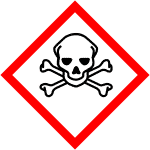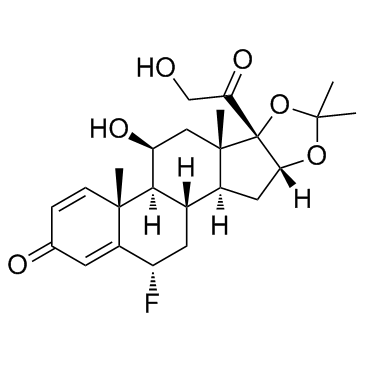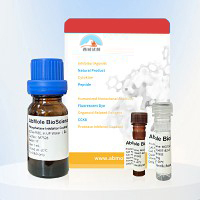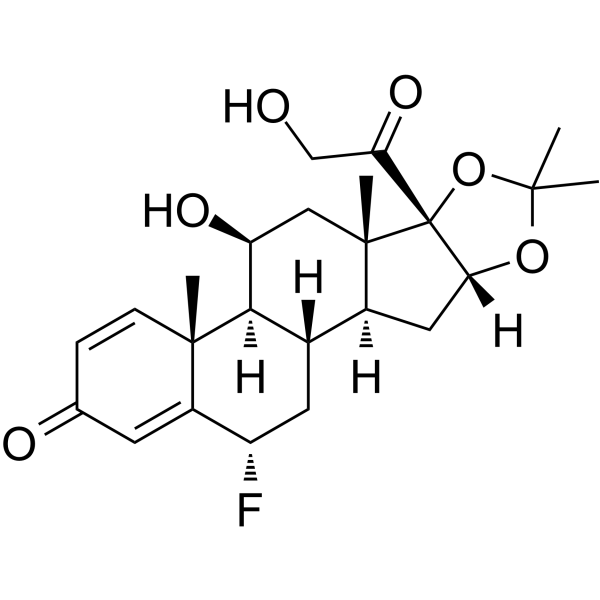Flunisolide 氟尼缩松,99.95%
产品编号:Bellancom-B1121| CAS NO:3385-03-3| 分子式:C24H31FO6| 分子量:434.50
Flunisolide是一种皮质类固醇, 常用于治疗过敏性鼻炎。Flunisolide的主要作用机制是激活糖皮质激素受体, 意味着它具有抗炎作用。
本网站销售的所有产品仅用于工业应用或者科学研究等非医疗目的,不可用于人类或动物的临床诊断或者治疗,非药用,非食用,
Flunisolide 氟尼缩松
| 产品介绍 | Flunisolide 是一种皮质类固醇,是具有口服活性的糖皮质激素受体 ( Glucocorticoid receptor ) 激活剂,具有抗炎活性。Flunisolide 可诱导嗜酸性粒细胞凋亡 (apoptosis),可用于哮喘或鼻炎、炎症的相关研究。 | ||||||||||||||||
|---|---|---|---|---|---|---|---|---|---|---|---|---|---|---|---|---|---|
| 生物活性 | Flunisolide is a corticosteroid, which is an orally active glucocorticoid receptor activator with anti-inflammatory activity. Flunisolide can induce eosinophil apoptosis, and is used for the research of asthma or rhinitis, and inflammation. | ||||||||||||||||
| 体外研究 |
Flunisolide (0.1-10 μM, 1 h) inhibits lung fibroblast (Isolated from lung) activation. Flunisolide (10 μM, 24 h) reduces MMP-9, TIMP-1, TGF-β and fibronectin release by sputum cells (isolated from mild to moderate asthmatics), and induces sputum eosinophil apoptosis. Flunisolide (0.1-10 µM μM, 24 h) effectively inhibits ICAM-1 expression and GM-CSF and IL-5 release induced by TNF-alpha in BEAS-2B cells. Flunisolide (115 µM, 0-3 h) can be transported in a polarized way in the apical (ap) to basolateral (bl) direction in Calu-3 cells and is demonstrated to be ATP-dependent[4]. 西域 has not independently confirmed the accuracy of these methods. They are for reference only. Apoptosis Analysis
|
||||||||||||||||
| 体内研究 (In Vivo) |
Flunisolide (Intranasal administration, 0.3–10 µg/mouse, daily, from days 21-27) inhibits lung inflammation, fibrosis, and airway hyper-reactivity, also improves clearance of silica particles from the lungs in silicotic mice. Flunisolide (Intranasal administration, 0.3–10 µg/mouse, daily, from days 21-27) inhibits silica-induced macrophage and myofibroblast accumulation in the lung tissue. 西域 has not independently confirmed the accuracy of these methods. They are for reference only.
| ||||||||||||||||
| 体内研究 |
Flunisolide (Intranasal administration, 0.3–10 µg/mouse, daily, from days 21-27) inhibits lung inflammation, fibrosis, and airway hyper-reactivity, also improves clearance of silica particles from the lungs in silicotic mice. Flunisolide (Intranasal administration, 0.3–10 µg/mouse, daily, from days 21-27) inhibits silica-induced macrophage and myofibroblast accumulation in the lung tissue. 西域 has not independently confirmed the accuracy of these methods. They are for reference only.
| ||||||||||||||||
| 体内研究 |
Flunisolide (Intranasal administration, 0.3–10 µg/mouse, daily, from days 21-27) inhibits lung inflammation, fibrosis, and airway hyper-reactivity, also improves clearance of silica particles from the lungs in silicotic mice. Flunisolide (Intranasal administration, 0.3–10 µg/mouse, daily, from days 21-27) inhibits silica-induced macrophage and myofibroblast accumulation in the lung tissue. 西域 has not independently confirmed the accuracy of these methods. They are for reference only.
| ||||||||||||||||
| 性状 | Solid | ||||||||||||||||
| 溶解性数据 |
In Vitro:
DMSO : 125 mg/mL (287.69 mM; Need ultrasonic) 配制储备液
*
请根据产品在不同溶剂中的溶解度选择合适的溶剂配制储备液;一旦配成溶液,请分装保存,避免反复冻融造成的产品失效。 In Vivo:
请根据您的实验动物和给药方式选择适当的溶解方案。以下溶解方案都请先按照 In Vitro 方式配制澄清的储备液,再依次添加助溶剂:
——为保证实验结果的可靠性,澄清的储备液可以根据储存条件,适当保存;体内实验的工作液,建议您现用现配,当天使用;
以下溶剂前显示的百
| ||||||||||||||||
| 运输条件 | Room temperature in continental US; may vary elsewhere. | ||||||||||||||||
| 储存方式 |
| ||||||||||||||||
| 参考文献 |
|
| 符号 |

GHS06 |
|---|---|
| 信号词 | Danger |
| 危害声明 | H300 |
| 警示性声明 | P264-P301 + P310 |
| 个人防护装备 | Eyeshields;Faceshields;full-face particle respirator type N100 (US);Gloves;respirator cartridge type N100 (US);type P1 (EN143) respirator filter;type P3 (EN 143) respirator cartridges |
| 危害码 (欧洲) | T+ |
| 风险声明 (欧洲) | 28 |
| 安全声明 (欧洲) | 28-36/37-45 |
| 危险品运输编码 | UN 2811 6.1 / PGI |
| WGK德国 | 3 |
| RTECS号 | TU3900000 |
|
Section 1. Chemical Product and Company Identification Flunisolide, Anhydrous Common Name/ Trade Name Flunisolide, Anhydrous Section 4. First Aid Measures Eye ContactCheck for and remove any contact lenses. In case of contact, immediately flush eyes with plenty of water for at
least 15 minutes. Get medical attention. Skin ContactIn case of contact, immediately flush skin with plenty of water. Cover the irritated skin with an emollient. Remove contaminated clothing and shoes. Wash clothing before reuse. Thoroughly clean shoes before reuse. Get medical attention. Serious Skin ContactWash with a disinfectant soap and cover the contaminated skin with an anti-bacterial cream. Seek immediate medical attention. InhalationIf inhaled, remove to fresh air. If not breathing, give artificial respiration. If breathing is difficult, give oxygen. Get medical attention. Serious InhalationEvacuate the victim to a safe area as soon as possible. Loosen tight clothing such as a collar, tie, belt or waistband. Seek medical attention. IngestionIf swallowed, do not induce vomiting unless directed to do so by medical personnel. Never give anything by mouth to an unconscious person. Loosen tight clothing such as a collar, tie, belt or waistband. Get medical attention immediately. Serious IngestionNot available. Section 5. Fire and Explosion Data Flammability of the Product May be combustible at high temperature. Auto-Ignition Temperature Not available. Flash PointsNot available. Flammable LimitsNot available. Products of CombustionThese products are carbon oxides (CO, CO2), halogenated compounds. Fire Hazards in Presence of Slightly flammable to flammable in presence of heat. Various SubstancesNon-flammable in presence of shocks. Explosion Hazards in Presence Risks of explosion of the product in presence of mechanical impact: Not available. of Various SubstancesRisks of explosion of the product in presence of static discharge: Not available. Fire Fighting MediaSMALL FIRE: Use DRY chemical powder. and InstructionsLARGE FIRE: Use water spray, fog or foam. Do not use water jet. Special Remarks onNot available. Fire Hazards Special Remarks on Explosion Not available. Hazards Section 6. Accidental Release Measures Small SpillUse appropriate tools to put the spilled solid in a convenient waste disposal container. Large SpillPoisonous solid. Stop leak if without risk. Do not get water inside container. Do not touch spilled material. Use water spray to reduce vapors. Prevent entry into sewers, basements or confined areas; dike if needed. Eliminate all ignition Flunisolide, Anhydrous Section 7. Handling and Storage PrecautionsKeep locked up.. Keep away from heat. Keep away from sources of ignition. Empty containers pose a fire risk, evaporate the residue under a fume hood. Ground all equipment containing material. Do not ingest. Do not breathe dust. Wear suitable protective clothing. In case of insufficient ventilation, wear suitable respiratory equipment. If ingested, seek medical advice immediately and show the container or the label. Avoid contact with skin and eyes. StorageKeep container tightly closed. Keep container in a cool, well-ventilated area. Do not store above 25°C (77°F). Section 8. Exposure Controls/Personal Protection Engineering ControlsUse process enclosures, local exhaust ventilation, or other engineering controls to keep airborne levels below recommended exposure limits. If user operations generate dust, fume or mist, use ventilation to keep exposure to airborne contaminants below the exposure limit. Personal ProtectionSplash goggles. Lab coat. Dust respirator. Be sure to use an approved/certified respirator or equivalent. Gloves. Personal Protection in Case of Splash goggles. Full suit. Dust respirator. Boots. Gloves. A self contained breathing apparatus should be used a Large Spillto avoid inhalation of the product. Suggested protective clothing might not be sufficient; consult a specialist BEFORE handling this product. Exposure LimitsNot available. Section 9. Physical and Chemical Properties Physical state and appearance Solid.OdorNot available. Not available. Taste Molecular Weight434.51 g/mole Not available. Color Not available. pH (1% soln/water) Boiling PointNot available. Not available. Melting Point Critical TemperatureNot available. Specific GravityNot available. Vapor PressureNot applicable. Vapor DensityNot available. Not available. Volatility Odor ThresholdNot available. Water/Oil Dist. Coeff.Not available. Ionicity (in Water)Not available. Dispersion PropertiesNot available. SolubilityNot available. Section 10. Stability and Reactivity Data StabilityThe product is stable. Instability TemperatureNot available. Conditions of InstabilityExcess heat Incompatibility with various Not available. substances Flunisolide, Anhydrous CorrosivityNot available. Special Remarks onNot available. Reactivity Special Remarks onNot available. Corrosivity PolymerizationWill not occur. Section 11. Toxicological Information Routes of EntryInhalation. Ingestion. Toxicity to AnimalsAcute oral toxicity (LD50): >0.5 mg/kg [Mouse]. Chronic Effects on Humans Not available. Other Toxic Effects onHazardous in case of skin contact (irritant), of ingestion, of inhalation. Humans Special Remarks onNot available. Toxicity to Animals Special Remarks onMay cause adverse reproductive effects (paternal and maternal effects, fetotoxicity) and birth defects based on Chronic Effects on Humansanimal data. No human data found at this time. Special Remarks on otherAcute Potential Health Effects: Toxic Effects on HumansSkin: May cause skin irritation. Eyes: May cause eye irritation. Inhalation: May cause respiratory tract irritation. May cause ulceration of nasal septum. Ingestion: Harmful if swallowed. May cause gastrointestinal tract irritation. May affect behavior/Central Nervous system (somnolence). May also affect metabolism (weight loss or decreased weight gain),and blood(aplastic anemia). Section 12. Ecological Information EcotoxicityNot available. BOD5 and CODNot available. Products of BiodegradationPossibly hazardous short term degradation products are not likely. However, long term degradation products may arise. Toxicity of the ProductsThe products of degradation are as toxic as the product itself. of Biodegradation Not available. Special Remarks on the Products of Biodegradation Section 13. Disposal Considerations Waste DisposalWaste must be disposed of in accordance with federal, state and local environmental control regulations. Flunisolide, Anhydrous Section 14. Transport Information DOT ClassificationCLASS 6.1: Poisonous material. Identification: Toxic Solid, Organic, n.o.s. (Flunisolide) UNNA: 2811 PG: III Not available. Special Provisions for Transport DOT (Pictograms) HARMFUL STOW AWAY FROM FOODSTUFFS 6 Section 15. Other Regulatory Information and Pictograms California prop. 65: This product contains the following ingredients for which the State of California has found to Federal and State cause cancer, birth defects or other reproductive harm, which would require a warning under the statute: Regulations Flunisolide, Anhydrous California prop. 65: This product contains the following ingredients for which the State of California has found to cause reproductive harm (female) which would require a warning under the statute: Flunisolide, Anhydrous California prop. 65: This product contains the following ingredients for which the State of California has found to cause birth defects which would require a warning under the statute: Flunisolide, Anhydrous California California prop. 65: This product contains the following ingredients for which the State of California has found Proposition 65 to cause birth defects which would require a warning under the statute: Flunisolide, Anhydrous Warnings Other RegulationsOSHA: Hazardous by definition of Hazard Communication Standard (29 CFR 1910.1200). EINECS: This product is on the European Inventory of Existing Commercial Chemical Substances. WHMIS (Canada) Not controlled under WHMIS (Canada). Other Classifications DSCL (EEC)R28- Very toxic if swallowed.S1/2- Keep locked up and out of the reach of R36/38- Irritating to eyes and skin.children. S28- After contact with skin, wash immediately with plenty of water. S36/37- Wear suitable protective clothing and gloves. S45- In case of accident or if you feel unwell, seek medical advice immediately (show the label where possible). S46- If swallowed, seek medical advice immediately and show this container or label. Health Hazard HMIS (U.S.A.)2 National Fire Protection 1 Flammability 1 Association (U.S.A.) Fire Hazard 2 0 Reactivity Health Reactivity 0 Specific hazard Personal Protection E WHMIS (Canada) (Pictograms) DSCL (Europe) (Pictograms) Flunisolide, Anhydrous TDG (Canada) (Pictograms) 6 ADR (Europe) (Pictograms) Protective Equipment Gloves. Lab coat. Dust respirator. Be sure to use an approved/certified respirator or equivalent. SECTION 16 - ADDITIONAL INFORMATION N/A |
 有竞争力的价格
有竞争力的价格匹配竞争对手的价格
 极速物流
极速物流效率为先
 技术支持
技术支持专业经验 贴心服务
 现货库存
现货库存50000+库存






 浙公网安备 33010802013016号
浙公网安备 33010802013016号